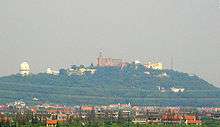Sheshan
Sheshan, formerly known as Zose, is a pair of hills in Songjiang District in western Shanghai, China. The two hills are distinguished as East and West Sheshan, although the more important western hill is also called Sheshan on its own. East Sheshan has an elevation of 100.8 m (331 ft) and West Sheshan has an elevation of 97 m (318 ft); there is a small valley between them. The area around the two hills is a forest park.
| Sheshan | |||||||||||||
|---|---|---|---|---|---|---|---|---|---|---|---|---|---|
 Sheshan, its observatory, and Our Lady of Sheshan Cathedral | |||||||||||||
| Chinese | 佘山 | ||||||||||||
| Literal meaning | She Hill(s) | ||||||||||||
| |||||||||||||
Basilica
It is surmounted by the Our Lady of China Catholic church, Sheshan Basilica, which was built there between 1925 and 1935 following its establishment as a chapel in the 1850s by European missionaries. Services in the church are held in Latin. The road to the top of Sheshan hill represents the Via Dolorosa (The Way of Suffering) that Christ took to his crucifixion. Every May pilgrims flock to the chapel and the holy road by the hundreds.
Observatory
The hill also houses an observatory founded by Jesuits, the Sheshan Observatory. In addition to scientific equipment of the modern era, it displays a replica of a Han dynasty earthquake monitoring device, consisting of a jar with dragon heads mounted around the outside and a pendulum inside. Each dragon has a steel ball in its mouth. When an earthquake occurred, the pendulum would swing, knock a dragon causing its mouth to open and a ball to drop out thereby indicating the quake's direction.
Transportation
Sheshan is in the vicinity of Sheshan Station on Line 9 of the Shanghai Metro.